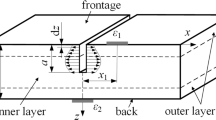Abstract
The manufacture of machined components for the aeronautics industry often involves the removal of large quantities of material, while the stringent demands on quality require special care to be taken during the manufacturing process. For most components of this kind, the principal source of distortion is the relaxation of residual stress after the earlier manufacturing processes. In this paper, the problem is addressed through modeling and simulating the final displacement fields obtained after different machining sequences of an aeronautic turbine component, in order to determine the optimum machining sequence among the options that lead to the same final part. Some of the main problems associated with this issue are also addressed, such as the high computational cost and time needed for simulations and expensive equipment needed for residual stress measurement. The level-set technique is employed, which decreases remeshing needs, while affordable nondestructive techniques for measuring residual stress are developed, providing qualitative information that is especially useful in industrial environments.
























Similar content being viewed by others
References
Masoudi S, Amini S, Saeidi E, Eslami-Chalander H (2015) Effect of machining-induced residual stress on the distortion of thin-walled parts. Int J Adv Manuf Technol 76:597–608. https://doi.org/10.1007/s00170-014-6281-x
Huang X, Sun J, Li J (2015) Effect of initial residual stress and machining-induced residual stress on the deformation of aluminium alloy plate. Stroj Vestnik/Journal Mech Eng 61(2):131–137. https://doi.org/10.5545/sv-jme.2014.1897
Werke M, Wretland A, Ottosson P, Holmberg J, Machens M, Semere D (2018) Geometric distortion analysis using a combination of the contour method and machining simulation. 51st CIRP Conf. Manuf Syst 72:1481–1486. https://doi.org/10.1016/j.procir.2018.03.213
Yang Y, Li M, Li KR (2014) Comparison and analysis of main effect elements of machining distortion for aluminum alloy and titanium alloy aircraft monolithic component. Int J Adv Manuf Technol 70(9–12):1803–1811. https://doi.org/10.1007/s00170-013-5431-x
Wang J, Zhang D, Wu B, Luo M (2018) Prediction of distortion induced by machining residual stresses in thin-walled components. 4153–4162. https://doi.org/10.1007/s00170-017-1358-y
Li J, Wang S (2017) Distortion caused by residual stresses in machining aeronautical aluminum alloy parts: recent advances. Int J Adv Manuf Technol 89:997–1012. https://doi.org/10.1007/s00170-016-9066-6
D’Alvise L, Chantzis D, Schoinochoritis B, Salonitis K (2015) Modelling of part distortion due to residual stresses relaxation: an aeronautical case study. 15th CIRP Conf. Model Mach Oper 31:447–452. https://doi.org/10.1016/j.procir.2015.03.069
Suárez A, Veiga F, Polvorosa R, Artaza T, Holmberg J, López de Lacalle LN, Wretland A (2019) Surface integrity and fatigue of non-conventional machined alloy 718. J Manuf Proc 48:44–50. https://doi.org/10.1016/j.jmapro.2019.09.041
Sim WM (2010) Challenges of residual stress and part distortion in the civil airframe industry. Int J Microstruct Mater Prop 5(4–5):446–455. https://doi.org/10.1504/IJMMP.2010.037621
Cerutti X, Mocellin K (2016) Influence of the machining sequence on the residual stress redistribution and machining quality: analysis and improvement using numerical simulations. Int J Adv Manuf Technol 83(1–4):489–503. https://doi.org/10.1007/s00170-015-7521-4
Cerutti X, Mocellin K, Hassini S, Blaysat B, Duc E (2017) Methodology for aluminium part machining quality improvement considering mechanical properties and process conditions. CIRP J Manuf Sci Technol 18:18–38. https://doi.org/10.1016/j.cirpj.2016.07.004
Osher S, Sethian JA (1988) Fronts propagating with curvature-dependent speed: algorithms based on Hamilton-Jacobi formulations. J Comput Phys 79(1):12–49. https://doi.org/10.1016/0021-9991(88)90002-2
Arrazola PJ, Özel T, Umbrello D, Davies M, Jawahir IS (2013) Recent advances in modelling of metal machining processes. CIRP Ann Manuf Technol 62:695–718. https://doi.org/10.1016/j.cirp.2013.05.006
Pierard O, Barboza J, Duflot M, D’Alvise L, Perez-Duarte A (2008) Distortions prediction during multi-pass machining simulations by using the level-set method. Int J Mater Form 1:563–565. https://doi.org/10.1007/s12289-008-0
Bieberdorf N, Towner Z, Hubbard NB, Gerstle W (2018) An evaluation of different plasticity and failure Laws in simulating puncture in 7075-T651 aluminum. Report, Sandia National Laboratories
Corona E, Orient GE (2014) An evaluation of the Johnson-Cook model to simulate puncture of 7075 aluminum plates. Report, Sandia National Laboratories
Schajer GS (ed) (2013) Practical residual stress measurement methods. University of British Columbia, Vancouver
Chantzis D, Van-Der-Veen S, Zettler J, Sim WM (2013) An industrial workflow to minimise part distortion for machining of large monolithic components in aerospace industry. 14th CIRP Conf. Model Mach Oper 8:281–286. https://doi.org/10.1016/j.procir.2013.06.103
Belytschko T, Moës N, Usui S, Parimi C (2001) Arbitrary discontinuities in finite elements. Int J Numer Methods Eng 50(4):993–1013. https://doi.org/10.1002/1097-0207(20010210)50:4<993::AID-NME164>3.0.CO;2-M
Cerutti X, Mocellin K (2015) Parallel finite element tool to predict distortion induced by initial residual stresses during machining of aeronautical parts. Int J Mater Form 8(2):255–268. https://doi.org/10.1007/s12289-014-1164-0
Kappmeyer G, Hubig C, Hardy M, Witty M, Busch M (2012) Modern machining of advanced aerospace alloys-enabler for quality and performance. Procedia CIRP 1(1):28–43. https://doi.org/10.1016/j.procir.2012.04.005
Funding
This research was funded by the Basque Government’s technology, innovation and competitiveness vice-counseling department, grant agreement kk-2019/00004 (PROCODA project).
Author information
Authors and Affiliations
Corresponding author
Additional information
Publisher’s note
Springer Nature remains neutral with regard to jurisdictional claims in published maps and institutional affiliations.
Rights and permissions
About this article
Cite this article
Casuso, M., Polvorosa, R., Veiga, F. et al. Residual stress and distortion modeling on aeronautical aluminum alloy parts for machining sequence optimization. Int J Adv Manuf Technol 110, 1219–1232 (2020). https://doi.org/10.1007/s00170-020-05816-7
Received:
Accepted:
Published:
Issue Date:
DOI: https://doi.org/10.1007/s00170-020-05816-7



